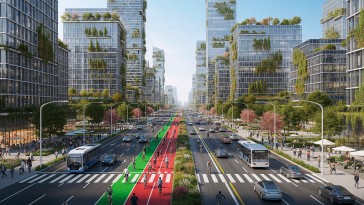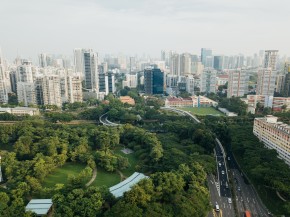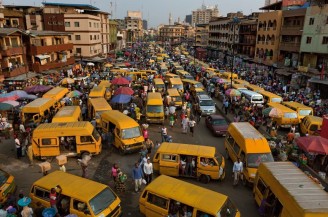Blog / Leadership & Transformation
Discover the 15-Minute City: A Game Changer for Urban Planners
Categories
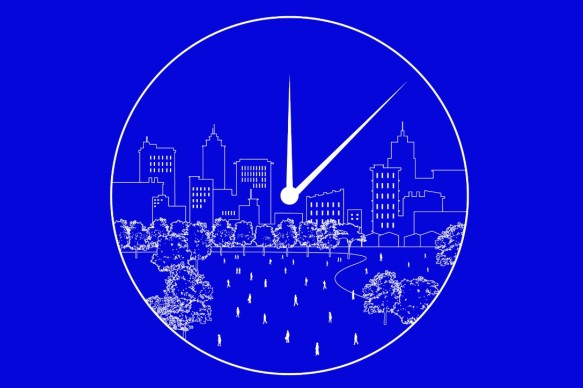
Picture yourself living in a city where everything you need, from your daily essentials to perhaps even your work and recreational facilities, is just a pleasant 15-minute walk or bike ride away.
Sounds like wishful thinking?
Fortunately, this dream is a reality thanks to the 15-minute city model. This innovative approach to urban planning aims to bring convenience, sustainability, and a renewed sense of community back into our daily lives.
The 15-minute city model encourages creating neighborhoods where every essential service - be it grocery stores, schools, offices, parks, health centers, or cultural hubs - can be easily reached within a 15-minute walk or bike ride. It offers a framework to transform our urban areas into smart, sustainable and, above all, livable cities.
But what does this model mean for smart city professionals and how can they leverage it effectively?
In this article, we will deep dive into the concept, origin, and advantages of the 15-minute city, understand its role in creating sustainable communities, and discover the best practices to implement this model. Additionally, for your smart city professionals, we'll hand over a comprehensive guide to adopting this approach.
Understanding the Concept of the 15-Minute City
The 15-minute city is an urban planning concept that turns our perspective of sustainable urban living on its head. Instead of sprawling cities where amenities are dispersed and residents are reliant on vehicles for transportation, the 15-minute city is all about proximity. The concept is simple yet transformative: structure cities in a way that every basic need—be it work, grocery stores, schools, doctors, or recreational parks— can be reached within a short, 15-minute walk or bike ride from home.
'People-centered urban design' is an accurate explanation of the 15-minute city model. It aims to build cities that cater directly to the needs of the residents, making their lives easier, healthier and more enjoyable.The 15-minute city embodies the ideals of a smart city: compact, eco-friendly, efficient and integrated.
This concept places a strong emphasis on neighborhood autonomy. In a 15-minute city setup, the neighborhood becomes a self-sustaining unit interconnected with the broader city. It seeks to balance urban and suburban life by offering the amenities and community of an urban area combined with the space and pace of a suburban area.
The implementation of the 15-minute city model requires a multifaceted approach. Urban designers play a pivotal role by providing innovative solutions to manage growth and humanize infrastructure projects. Moreover, embracing meaningful public engagement tools provided by urban design is a key step towards successful implementation. Accepting and incrementally improving life in all neighborhoods, even the stigmatized ones, is also a vital aspect of this model.
In cities where the 15-minute model is being pursued, such as Copenhagen, we've seen significant urban transformation. The Five-Finger Plan for metropolitan train transportation in Copenhagen is a potent example of how urban design solutions can serve to realize the essence of the 15-minute city model.
Apart from the reductions in commute times and the environmental benefits, the 15-minute city can help foster strong community ties. Given the proximity of everything, residents are encouraged to walk or bike, which invariably provides more opportunities for social interactions.
Smart city professionals, this could be the future of urban living! We're on the cusp of a revolution in urban design, and the 15-minute city sits at the helm.
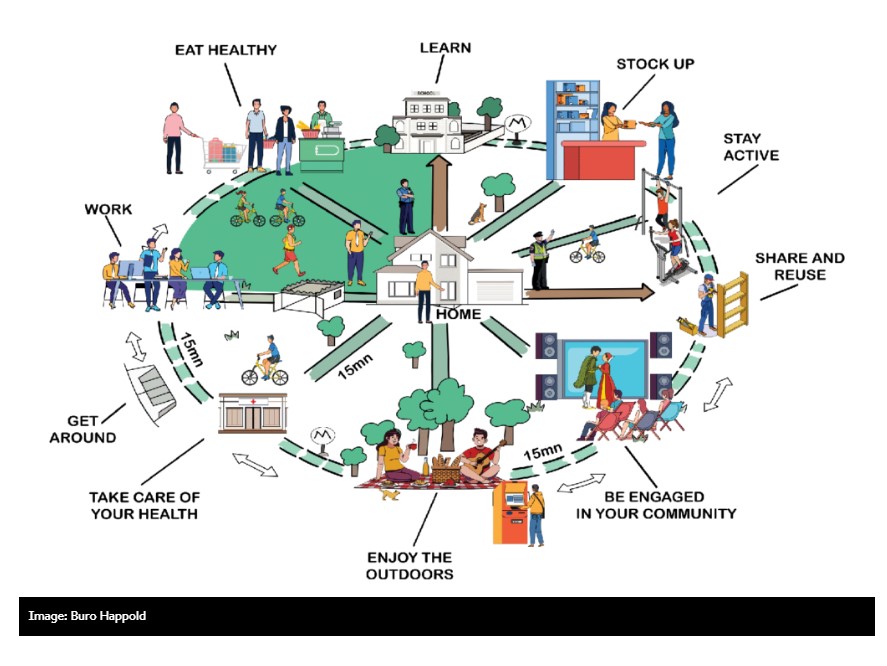
The Genesis of the 15-Minute City: An Overview
You may wonder where the idea of a 15-minute city sprouted from. Notable cities like Copenhagen and Brasilia offer some insights. Dating back to 1947, Copenhagen adopted the Five-Finger Plan, a radical approach to metropolitan train transportation. The plan combined urban design and transportation planning to facilitate ease of accessible city services, thereby bringing the concept of the 15-minute city to life.
On the other side of the world, Brasilia surfaced around the principles of the Functional City, conceptualized by the renowned architect, Le Corbusier. The model city aimed to create functional, self-sufficient units of urban living, effectively mirroring the core principle behind the 15-minute city model. These cities were a precursor, shedding light on how urban design and planning could reshape our communities to promote accessibility and efficiency.
The role of urban designers in this process could not be overstated. They have played a crucial role, both as problem-solving supporters of comprehensive planning and infrastructure development efforts, and as leaders or managers of complex professional teams. By engaging the public with a variety of participation tools and addressing community concerns, these professionals have been able to promote the idea of a 15-minute city.
Consequently, the genesis of this concept is deeply rooted in cities that were able to solve complex issues through well-thought-out plans and designs, prioritizing human-centric factors revolving around accessibility, functionality, and sustainability. As social interactions and work dynamics evolve, the relevance and prominence of the 15-minute city within urban planning discourse are set to increase.
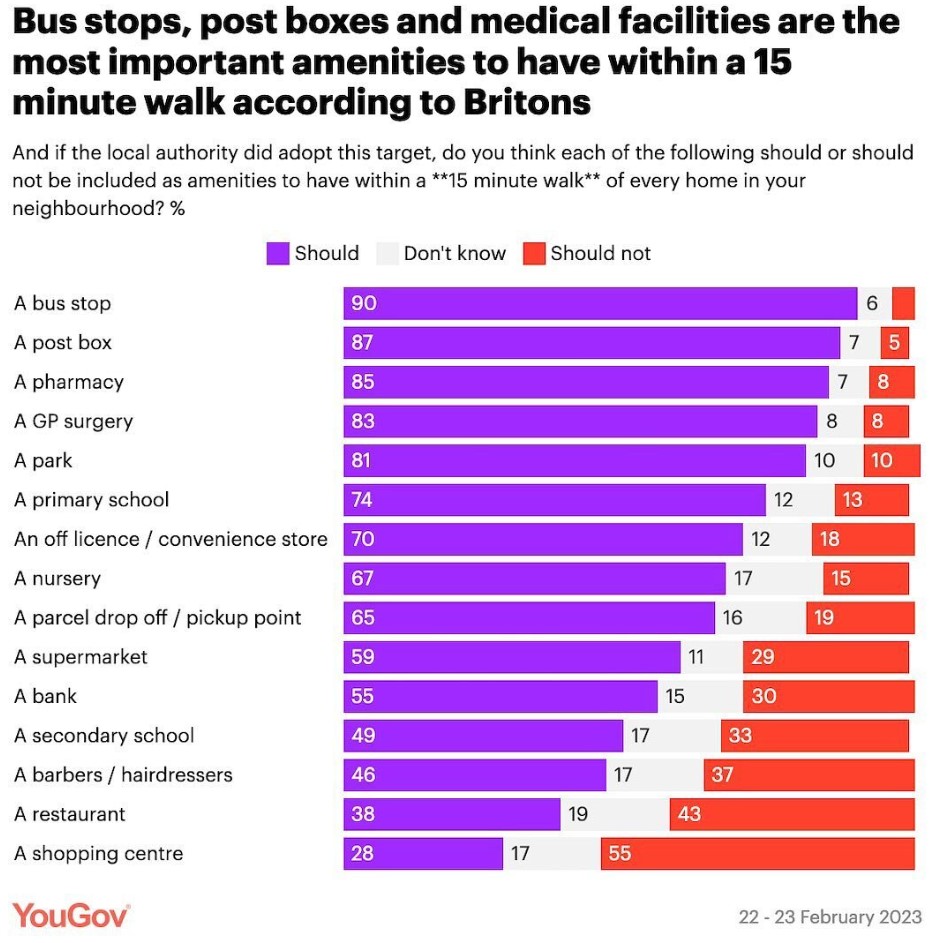
Carlos Moreno and the 15-Minute city in Paris
Carlos Moreno, the urban scientist and pioneer of the 15-Minute City concept, has brought a revolution in Paris. Moreno's model operates on the profound idea that residents should be able to meet most, if not all, of their needs within a short walk or bike ride from their homes. It's a visionary scheme that's reshaping the city of love, all while promoting eco-friendliness and enhancing community cohesion.
Moreno's ideas have found not only academic affirmation but also practical implementation. The Mayor of Paris, Anne Hidalgo, has embraced Moreno's concept wholeheartedly, incorporating it into her urban planning strategy. The aim is to transform the bustling city into 'ville du quart d'heure,' or 15-minute city, where stores, parks, cafes, sports facilities, health centers, schools, and workplaces are just a few minutes away.
The lesson, clearly, is that smart city professionals worldwide can learn from such best practices. Consider the practical implementation of the 15-minute city model in Paris as inspiration. Cities are evolving rapidly, and professionals looking to cater to citizens' requirements while minimizing environmental impact will find Moreno's work insightful and forward-thinking.
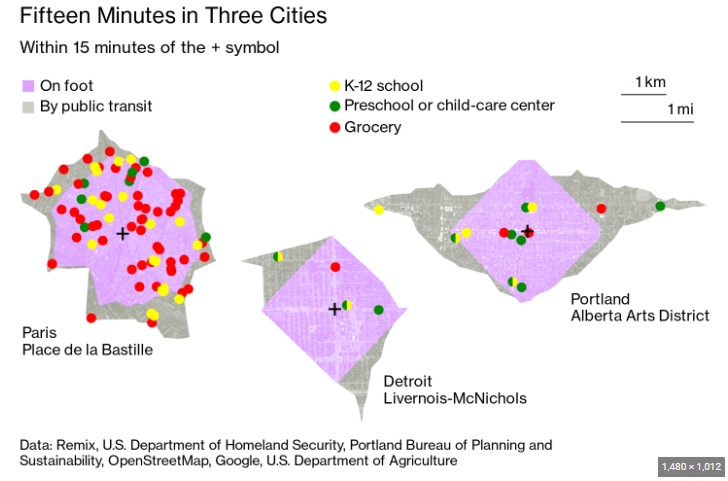
Take your city planning vision to the next level by incorporating strategies that enhance communal living while fostering environmental sustainability, emulating the 15-minute city model's attributes. It's a move that will undoubtedly make cities more livable, equitable, and resilient.
Exploring the Advantages of the 15-Minute City Model
The 15-minute city model presents a rich tapestry of benefits, particularly for urban design professionals engaged in creating sustainable communities:
- Humanizes Large Infrastructure Projects: Embeds growth management within the urban environment, offering an engaging career path for urban designers focused on addressing community challenges.
- Revitalizes Stigmatized Neighborhoods: Transforms environments by ensuring all essential services are accessible within a short walk or bike ride, reducing pollution and commuting times, and fostering community pride.
- Promotes Sustainable Urban Design: Demonstrated by Copenhagen's integration of metropolitan train transportation with city design, showing that urban solutions can be both sustainable and effective.
- Improves Social Interactions and Work Dynamics: Encourages a compact yet intricately connected urban layout, enhancing work-life balance by allowing people to live, work, and play in close proximity.
- Encourages Public Engagement: Utilizes tools like visual preference surveys and hands-on exercises for meaningful community involvement in urban planning, essential for developing community plans and large-scale redevelopment strategies.
- Addresses Human Needs Compassionately: Crafts spaces that intelligently and compassionately respond to human needs, changing the way people live by prioritizing reduced commutes and green living.
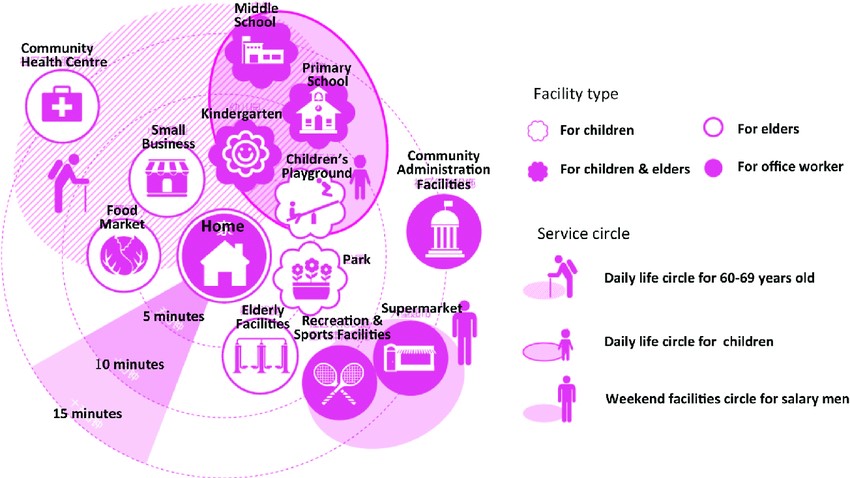
On the whole, the 15-minute city model presents urban design professionals with an opportunity to craft spaces that respond intelligently and compassionate to human needs. It's not just about reduced commutes and green living—this urban strategy fundamentally changes how people live their lives.
How Can Smart City Professionals Benefit from the 15-Minute City Model?
As a smart city professional, you are uniquely positioned to contribute to and reap the benefits from the 15-minute city model. Here's how:
- Implement Growth Management Activities: Urban design is instrumental to growth management. The 15-minute city model is a growth management strategy that enhances access to essential services and reduces commute time. As a smart city professional, you can utilize your insights and expertise to implement this model effectively, potentially transforming urban landscapes for the better.
- Humanize Infrastructure Projects: Within the 15-minute city model, emphasis is not just on efficiency, but also on people-friendly design. It offers an opportunity to humanize large infrastructure projects, ensuring they cater to the needs and aspirations of city dwellers. You can bring your understanding of urban communities into the mix, combining aesthetics, practicality, and socio-economic considerations in service provision.
- Engage Public Participation: The 15-minute city model requires a holistic, citizen-centric approach. Employing public engagement tools can ensure a more inclusive and efficient implementation. Techniques such as visual preference surveys and hands-on exercises can be extremely productive in understanding community preferences and incorporating them into planning and decision-making processes.
- Leadership and Management: As a smart city professional, you can contribute in dual ways; as a problem-solver in the comprehensive planning of infrastructure and as a leader managing complex professional teams. By taking the reins, you can help direct the 15-minute city model towards ending urban sprawl, creating integrated, cohesive communities.
- Embrace a Future-Focused Urban Model: The 15-minute city model is a response to changing urban core areas and a prediction for future social interactions and work dynamics. As a smart city professional, adopting this model lets you be ahead in creating sustainable, people-centric urban spaces.
Remember, as a smart city professional, your skill set is crucial for crafting effective urban designs. Whether it's implementing growth management activities, humanizing infrastructure projects, leading complex teams, or involving public participation in decision-making processes, your role in developing 15-minute cities is pivotal. And not to forget, in doing so, you contribute to a future of better, sustainable urban living.
Creating Livable, Sustainable Communities: The 15-Minute City Model
Urban design, as a discipline, is central to the implementation of the 15-minute city model. But how does this come into play? You may ask. It involves the strategic shaping of a community's physical form to meet multiple community objectives and interests.
Urban design presents us with a variety of public engagement tools, ensuring meaningful participation in shaping our urban spaces. Just as you would involve various stakeholders in a major project, incorporating the input of the inhabitants of a 15-minute city is paramount. More so, given the model's focus on localised access and community-oriented living.
Importantly, urban design provides potential solutions to managing growth and enhancing infrastructure projects within the 15-minute city model. This could involve applying design tools for transit-oriented development efforts, downtown plans, and large-scale redevelopment strategies, all crucial to creating sustainable, livable communities.
Let's talk for a minute about stigmatized neighborhoods. While we aim for progress, embracing and improving life in these neighborhoods is a crucial step. A transformatory urban design can slowly enhance these areas, align them with the 15-minute city concept, and shape a better urban future.
The role of urban design in addressing environmental challenges, often present in urban, suburban, and even rural communities, cannot be overlooked. Integration of disciplines such as transportation, land use, environmental protection, and housing, paves the way for the 15-minute city model to support living sustainable communities.
Public engagement is an essential ingredient in urban design projects. Techniques like visual preference surveys and hands-on exercises can aid in involving the community wholly in the decision-making process. At the end of the day, the 15-minute city model thrives on enabling everyday citizens to have a voice and a hand in shaping their urban spaces.
Transforming Urban Lives with the 15-Minute City
Envision a city where everything you need is available within a short 15-minute walk or bike ride. This is the reality of the 15-minute city model and it's poised to transform urban lives. But it's not just about convenience — it is also fundamentally about creating a more equitable, sustainable, and livable environment for all.
- Current urban designs often lead to sprawling suburbs, necessitating long and often inefficient commutes to work, school, and leisure facilities. This not only impacts individual wellness due to stress and lost time, but also air quality due to increased emissions. The 15-minute city model seeks to reconfigure this imbalance, understanding that the way we organize our cities directly impacts our quality of life and the health of our planet.
- By bringing amenities and essentials closer to home, the 15-minute city model fosters stronger community bonds. Reduced travel times encourage more engagement with local businesses and neighbors, creating a sense of belonging and increased security. This approach also facilitates local employment opportunities, stimulating the local economy while reducing the need for extensive travel.
- Furthermore, with the significant reduction or even elimination of commuting, more time can be allocated to family, leisure, and personal growth. Increased walking or cycling will contribute to better physical health of citizens, simultaneously reducing carbon emissions and air pollution from motor vehicles.
- The role of urban designers in building these communities cannot be understated. They act as both problem-solvers and leaders, integrating disciplines such as transportation, land use, environmental protection, and housing. They are tasked with manipulating the physical environment to address human behavior and involving the public in decision making, allowing for meaningful participation.
- It's clear that the 15-minute city model represents a real opportunity to reshape urban spaces, strengthening our communities, and enhancing our lives. Future predictions suggest a shift in focus from urban core areas to more local-centric neighborhoods, rethinking work dynamics, and social interactions in the process. The 15-minute city could be the future of urban living.
Best Practices to Implement the 15-Minute City Model
Take a page out of Copenhagen's book, they utilized the Five-Finger Plan for metropolitan train transportation, a stunning demonstration of urban design's potential. By envisioning and implementing a truly interconnected city with its outskirts as fingers splayed from a palm, they have indeed made significant strides towards a 15-minute city model. The pivotal role of urban design solutions in growth management and unraveling seemingly gigantic infrastructure projects can't be underscored enough.
- Consider the key elements of urban design, as they can significantly guide your steps in forming a 15-minute city. Factors such as manipulation of the physical environment to address human behavior can be instrumental in transforming urban spaces. Also, keep in mind the implications of form-giving actions. Are you building a city for cars or people? A 15-minute city should be a walkable, people-centric city, where all essential amenities are within a short stroll or bike ride. An understanding of pursuing multiple objectives for multiple clients will come in handy too. Let's not forget, a city is not a solitary beast; hence, it requires constant adjustments to accommodate various needs and expectations.
- Involve the Public: A cardinal rule in implementing a 15-minute city model is public engagement. Harness techniques such as visual preference surveys and hands-on exercises to actively involve your community in the decision-making process. After all, who better to direct the shaping of a city than those who live in it? As much as possible, you should aim to create settings and viral events that minimize exclusion and maximize inclusion. This helps create a sense of ownership and pride among residents, advancing the longevity and success of your 15-minute city model.
- Understand the power of incremental improvement, particularly in stigmatized neighborhoods, should not be overlooked. A city that works for everyone is a city that works. Therefore, as a smart city professional, you must embrace the imperfections and be willing to continuously improve.
- Think of urban design as a career choice: For individuals seeking to address significant community challenges, urban design could just be the key. Not only does urban design offer you the creative freedom to shape cityscapes, but it also avails you the tools and skills necessary to design cities that work for everyone.
In conclusion, the journey to creating a 15-minute city is paved with persistence, innovation, and robust public engagement strategies. It's not just about building a physical city, but also about cultivating an open, integrated, and sustainable community.
Guidelines for Smart City Professionals: Adopting the 15-Minute City Approach
If you're an urban planner or professional bound to the concept of smarter cities, it's crucial to embrace the 15-minute city approach. Here are some comprehensive, tried and tested guidelines to ensure you're navigating the planning and implementation of this urban model strategically and effectively.
- Prioritize Urban Design
Significant value lies in the thoughtful design of urban spaces, and as an urban professional, your role in manipulating the physical environment cannot be overemphasized. Prioritizing urban design in your 15-minute city model will add to its attractiveness, functionality, and sustainability. Urban design's flexible public engagement tools are key to fostering meaningful participation and creating environments tailored to suit human behavior. Copenhagen's Five-Finger Plan, a successful implementation of metropolitan train transportation, is one example of how clever urban design can enhance a city.
- Advocate for Incremental Improvement
The 15-minute city approach emphasizes the importance of accepting the current state of stigmatized neighborhoods and working towards their gradual improvement. This means focusing on small yet significant changes, such as enhancing communal spaces, introducing greenery, or improving public transportation access. These incremental changes can significantly contribute to a neighborhood's evolution over time.
- Be Knowledgeable about Community Challenges
Seek to understand and address critical community challenges. An effective urban designer acknowledges the complexities and specificities of diverse communities, and designs the urban environment accordingly. Consider how your plans will impact all residents, not just a privileged few, and anticipate potential issues before they arise.
- Ensure Public Engagement
Public participation is a cornerstone in urban design and a vital aspect of the 15-minute city concept. Employ techniques such as visual preference surveys, hands-on workshops, and public forums to engage the community in the decision-making process. This not only ensures public buy-in but brings diverse perspectives to the table, leading to more informed, inclusive, and enduring solutions.
- Embrace Complexity
Leading or participating in complex professional teams is part of an urban designer's role. The 15-minute city model should encourage you to embrace these complexities rather than avoid them. Diverse perspectives can strengthen your approach, create innovative solutions, and drive efforts towards the successful realization of the 15-minute city concept.
- Master the Art of Problem Solving
The 15-minute city approach is not immune to challenges. As a smart city professional, your job is to turn these challenges into opportunities for growth and improvement. Mastering the art of problem solving will contribute significantly to your work in creating highly functional, sustainable, and extremely efficient cities, whether you're developing a comprehensive plan or executing infrastructure development efforts.
In following these guidelines, you place yourself in a prime position to help build livable, sustainable communities that truly embody the spirit of the 15-minute city model. Remember, success in implementing this approach requires strategic planning, strong leadership, and the commitment to positive, transformative change.
Transform urban life with a Smart Cities Master
If the concept of the 15-Minute City interests you, and you are motivated by changing the lives of citizens worldwide, then you can check out our Smart Cities Master. It's a one-year live-online programme that gives you the startegic frameworks and practical tools to manage smart city projects and engage efficiently with all city stakeholders.
Guillermo Corral Comeras, urbanist and professor of the Master's, further develops the concept of the 15-minute city in this video:


